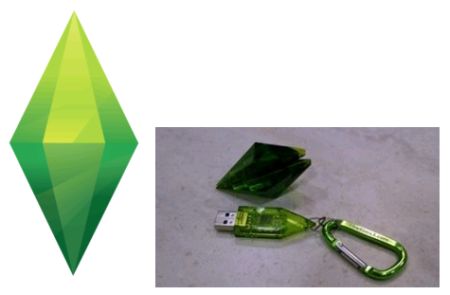When we talk these days about the role of functionality in determining the copyrightability of a useful article, we are generally talking about the 10 different separability tests currently duking it out at the Supreme Court in the Varsity Brands case. Our posts on that case are here, here and here. These tests enforce the Copyright Act's restriction that extends protection to pictorial, graphic or sculptural works "only if, and only to the extent that, such design incorporates PGS features that can be identified separately from, and are capable of existing independently of, the utilitarian aspects of the article."
The 10 tests developed by courts take various factors into consideration, such as the designer's intent or whether the copyrightable element could stand alone without impacting the article's functionality. The tests generally exist on a continuum – on the one end is a trade-dress-like prohibition against protecting any functionality through copyright, and on the other is a more design-patent-like multiplicity of forms analysis that could admit some protection for functionality where there are multiple ways to design the same function.
The Ninth Circuit, however, in Direct Technologies, LLC v. Electronic Arts, Inc., Nos. 14-56266, 14-56745 (9th Cir. Sept. 6, 2016), has just opened up a new front on the copyright and functionality debate in the narrow field of copyrightability of three-dimensional works that are derivative of an underlying two-dimensional work. The court's test appears to sidestep the current separability tests, and its test may be impervious to whichever separability test survives Supreme Court review in Varsity Brands. Most interestingly, the test employed by the Direct Technologies court appears to be a pure design-patent-like multiplicity of forms test.
The article at issue in Direct Technologies was a USB drive. Plaintiff DT was asked by defendant EA (through production company Lithomania) to create a prototype that rendered EA's "PlumBob" icon from its popular Sims video game into a 3-D thumb drive. The PlumBob icon floats above the head of the player's Sims character in the video game to help locate and identify the character. An example of the PlumBob and the 3-D USB drive are below:

Lithomania then allegedly took the prototype to a Chinese manufacturer, which re-created it and produced the USB drive for 50 cents less per unit than the price quoted by DT. DT sued EA for copyright infringement, among other things, for selling the Chinese knockoff version.
EA moved for summary judgment, claiming in part that the 3-D thumb drive was a derivative work of the 2-D icon and that DT did not add any new protectable expression in the process of the conversion. DT countered that it "made a non-functional contribution to the USB drive by designing the flash drive to fit into the PlumBob with a 'futuristic cut away look ... at a unique angle.'" Evidence on the issue was mixed. One DT employee testified that the cutaway design was driven by functional concerns because other designs had a USB drive that was "too fat" and would interfere with cables and other USB slots when being used. However, evidence also showed that four other design options were considered, and the designer for DT submitted a declaration that he chose the final design "for aesthetic reasons."
The court found that an issue of fact was presented regarding copyrightability issues. The court found that the DT employee's assertion that the final design "reflected the only way to design the drive while maintaining its functionality is certainly debatable – at least two of the other options that [the designer] considered appear to have been able to function as a normal USB flash drive." The court rejected EA's assertion that enforcing a copyright would create a "monopoly on all USB [drives] shaped like the PlumBob," because "[a]nyone else would be free to create a USB flash drive that used a different method or design for flash-drive removal, and DT's copyright would obviously not preclude others from making a 3-D PlumBob without a flash drive."
The court's reasoning sounds an awful lot like application of the multiplicity of forms type of test employed in determining whether aspects are covered by a design patent. See, e.g., Rosco, Inc. v. Mirror Lite Co., 304 F.3d 1373, 1378 (Fed. Cir. 2002) ("We apply a stringent standard for invalidating a design patent on grounds of functionality: the design of a useful article is deemed functional where the appearance of the claimed design is dictated by the use or purpose of the article. [T]he design must not be governed solely by function, i.e., that this is not the only possible form of the article that could perform its function.").
This is especially interesting because the Ninth Circuit is generally considered to employ a fairly restrictive approach when considering the copyrightability of useful articles. Known colloquially as the Poe/Nimmer approach, this approach gives substantial weight to the "capacity of the item to moonlight as a piece of marketable artwork" when determining whether the copyrightable element is separable from the utilitarian object it adorns. J. Galiano & Gianna, Inc. v. Harrah's Op. Co., 416 F.3d 411, 420 (5th Cir. 2005). This test takes its name from the Ninth Circuit's decision in Poe v. Missing Persons, 745 F.2d 1238 (9th Cir. 1984), as well as the Nimmer treatise on copyright, and although Poe was cited in the Direct Technologies decision, it was only for the premise that determination of functionality is a fact question for a jury.
The Direct Technologies court did not in any meaningful way mention the limits placed on copyright for a useful article imposed by 17 U.S.C. § 101. It did not perform any analysis on which aspect of the USB drive was "separable" from the drive itself and its uses. Instead, it appears that the district court below will be holding a trial on whether there is more than one way to design a PlumBob USB drive so that the drive portion is removable and useful. If there is, it appears copyright protection will be granted to DT's design. By focusing the court on the copyrightability of derivative works, as opposed to copyrightability of a useful article, it appears that DT has found a way to circumvent the morass of § 101 tests, and create a robust application of copyright law to boot.
The content of this article is intended to provide a general guide to the subject matter. Specialist advice should be sought about your specific circumstances.

